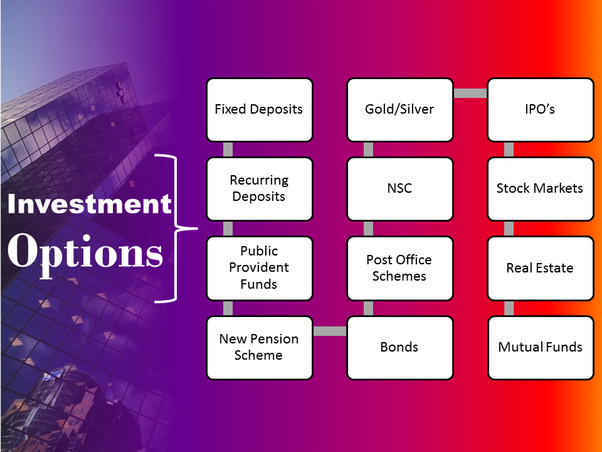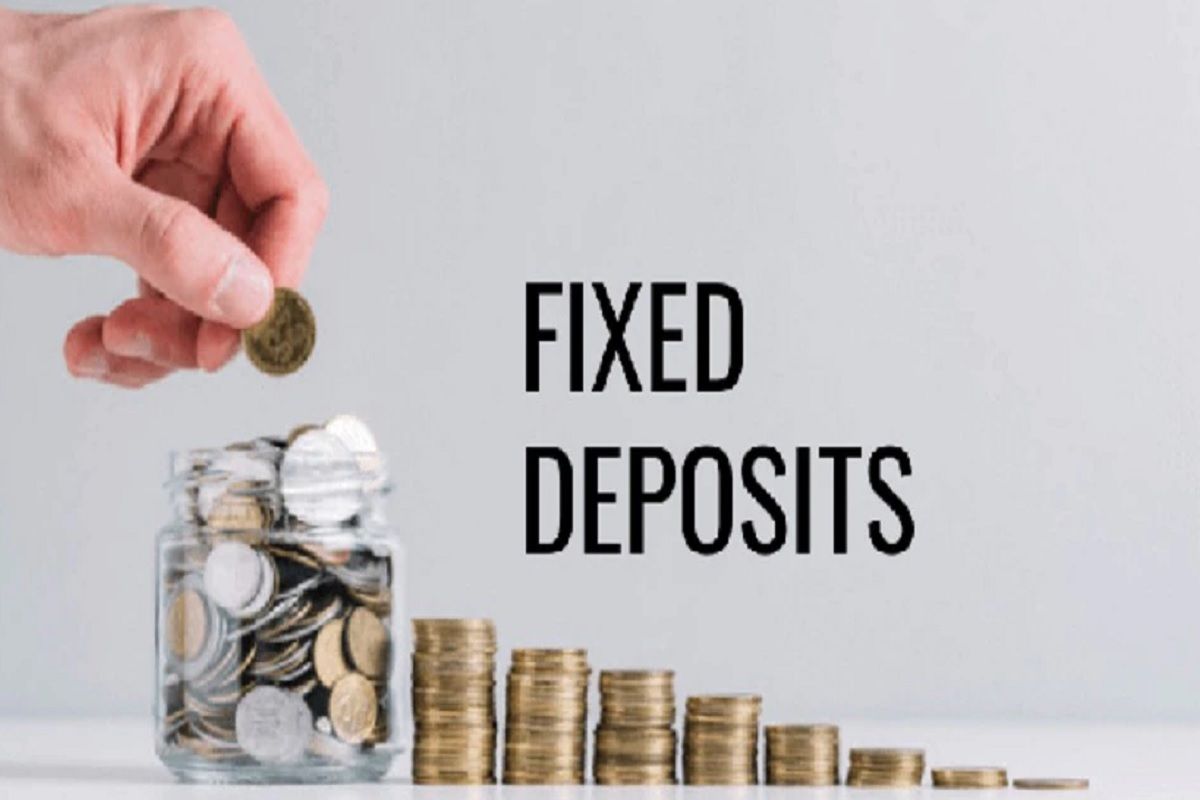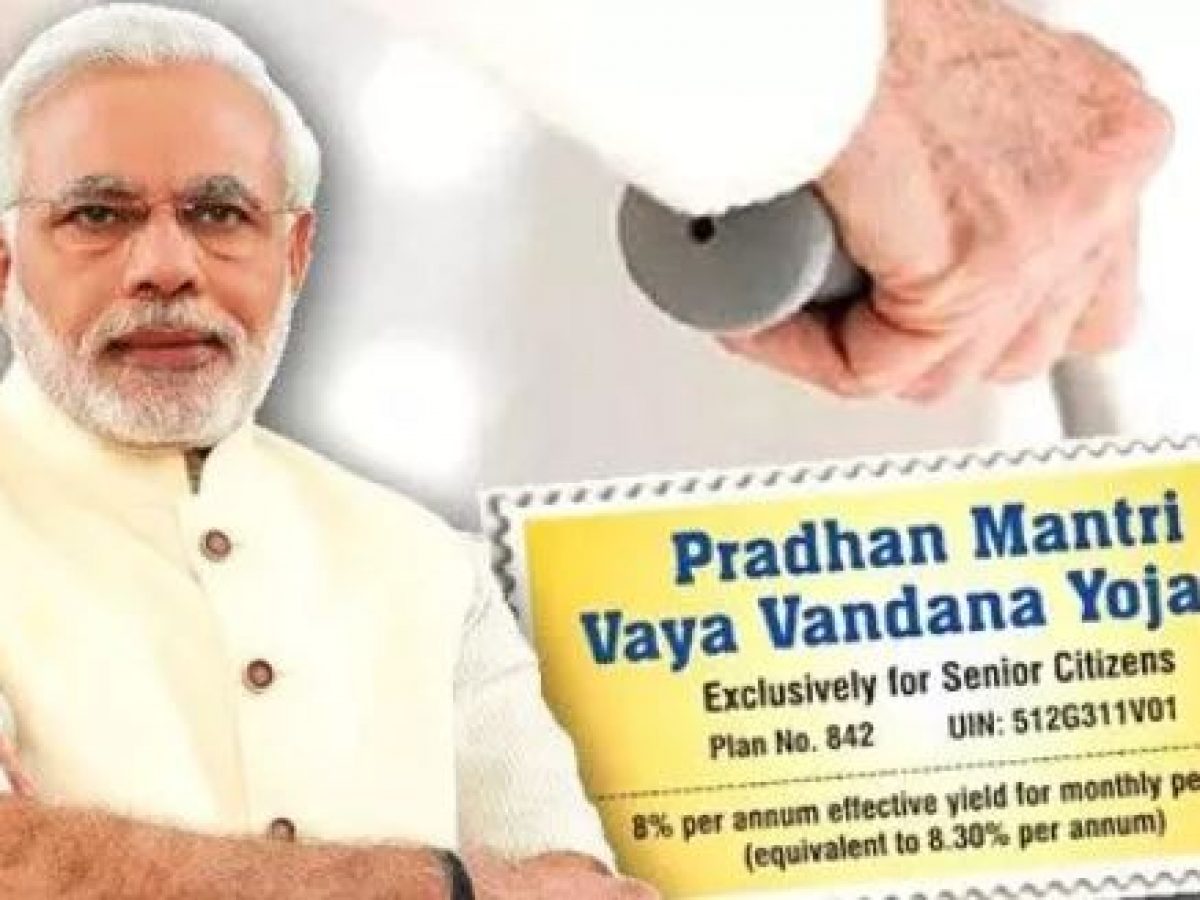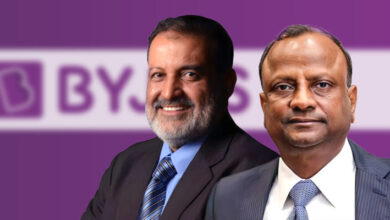Best Investment Options in India 2022

When it comes to the best investment options in India, a lot of questions pop up in the mind of people. Every investor wants to invest in the Best Investment options in India in a way that they can avail maximum return in a specific tenure with minimum risk involved.
This is the reason why smart investors are always on a lookout for the best investment options in India, where they can multiply their money in a specific time frame with minimum or no risk involved. However, it is hard to find an investment plan, which comes with a combination of high returns and low risk.

In reality, the returns and risks are directly proportional to each other, which means the higher the risk involved, the higher the chances of returns will be. In India, investment options can be broadly classified into two categories i.e. financial and non-financial assets. We can further divide the financial assets into market-linked securities such as mutual funds, live stocks, etc. and fixed income products like Bank FDs, Public Provident Fund (PPF), Bank RDs, etc. Non-financial assets consist of gold investment, real estate, treasury bills, etc.
While choosing the investment plan, it is inevitable to match the risk profile of the investor with the related risk of the product before investing. There are some investment plans in the market which includes high risk but also have the potential to gain profitable returns in the long-term as compared to the other asset classes. On the other hand, some of the investment options include lower risk, but the returns are also low.
By investing in the best investment options in India, you can not only achieve your financial goals but can also create a financial cushion for the future to live a secure life. This is the reason why investors are always in search of top investment plans where they can multiply their money as per their risk appetite. Further here, we have discussed in detail the top investment options in India, that can help the investors to achieve their financial goals.
Top Investment Options in India
Listed below are some of the best investment options in India 2022 that offer high returns. You can consider including these investment plans in your financial portfolio while savings for the future.
| Investment Options | Period of Investment (Minimum) | Who Can Invest | Risks | Returns Offered |
| Direct Equity | NA | An investor who knows to balance risk and return | High | NA |
| Mutual Funds | Within a scheme like ELSS a lock-in period of 3 years | An investor who has an appetite for medium to high risk | Low-High | Market-Linked |
| National Pension Scheme | 60 years | An investor looking forward to retirement plans | Low-High | Market-linked ( 8 to 10 per cent) |
| Public Provident Fund (PPF) | 15 years | Long-term investment goals | Nil | 7.9 per cent |
| Bank Fixed Deposits | 7 days | One who doesn’t wish to take the risk or be exposed to an equity | Nil | Fixed Returns, different from bank to bank |
| Senior Citizen Savings Scheme (SCSS) | 5 years | Senior Citizens | Nil | 8.7 per cent |
| Real Estate | 5 years | Anyone | Medium | 19-15 per cent |
| Gold ETF | NA | Anyone | Low – Medium | Market-linked |
| RBI Bond | 7 years | Indian Citizen |
Nil |
7.75 per cent |
| Pradhan Mantri Vaya Vandana Yojana (PMVVY) | 10 years | Senior Citizens | Nil | 7.4 per cent |
| Unit Linked Insurance Plan (ULIP) | Less or equals to 45 years | An investor keen on wealth creation and life cover | High | Depending on the investor’s profile |
| Post Office Monthly Income Scheme (POMIS) | 5 years | Indian Citizen | Nil – Low risk | 7.7 per cent |
| Initial Public Offerings (IPO) | NA | An investor should have Demat cum trading account | Moderate-High | NA |
Now, let us take a quick understanding of each of the best investment options with high returns in India 2022 one by one:
1. Unit Linked Insurance Plan (ULIP)

Unit-linked insurance plans are considered as one of the best investment options in India. The ULIP plans offer the dual benefit of insurance and investment. Besides, ULIP plans also provide the advantage that is tax exemption. ULIP plans arrive along with a lock-in period of 3 years-5 years. Under ULIP, a part of the premium is used for insurance coverage whereas the remaining premium is invested in market-linked instruments such as shares, bonds, much more.
Features of ULIP:
-
Investing in a ULIP is flexible as it provides the investor with the bandwidth to invest as per the risk appetite.
-
ULIP’s are a long-term investment and helps you to reap maximum returns.
-
ULIP lets you avail tax-free maturity.
It lets you pay a premium at the pre-defined time and enjoy the benefits for the complete policy period.
2. Public Provident Fund (PPF)

One of the most secured long-term investment option amongst all the investment options in India. It is tax-free. A PPF account can be opened in a bank or post office. The invested money is locked for the tenure of 15 years. Moreover, in this investment option, you can earn compound interest on the accumulated money.
You can also extend the time frame for the next five years. The only drawback of having a PPF account is that you can withdraw the invested money by the end of 6th year. In case you need the money, you can take a loan on the balance of the PPF account.
PPF Interest Rate From 2012 to 2022
Let’s take a look at the interest rates offered by PPF account from the year 2012-2022:
| Financial Year | Interest Rate |
| 2012-2013 | 8.80 |
| 2013-2014 | 8.70 |
| 2014-2015 | 8.70 |
| 2015-2016 | 8.70 |
| 2016-2017 | 8.10 |
| 2017-2018 | 7.60 |
| 2018-2022 | 7.60 |
**PPF rates represented above are for the last 7 years.
**The interest earned on PPF is tax-free; this makes it one of the best investment options in India.
Features of Public Provident Fund:
-
Being a government-backed scheme, PPF the principal along with the interested amount in the PPF account is safe and guaranteed.
-
Upon the investment, it has a lock-in period of 15 years. The lock-in period can also be extended for up to 5 years post the completion of the lock-in period.
-
On an annual basis, the minimum premium amount to be invested is Rs 500 up to Rs 1.5 lakh.
-
PPF also provides the benefit of availing loans against the amount of investment.
3. Mutual Fund

One of the prominent investment options in India- mutual funds is the ideal investment plan that offers high returns on the investment over the long term. It is a market-linked investment alternative, which invests money in various financial instruments such as equity, debt, stocks, money market fund, and much more.
The returns are generated as per the market performance of the fund. Even though the risk exposure in mutual fund investment is higher, it offers much better returns as compared to other best investment options in the market. The two major investment options offered by mutual funds are:
-
Equity Mutual Fund: Equity funds are market-linked securities. Being one of the prominent mutual funds in India, equity mutual funds offer high ROI by investing in shares of companies of different market capitalization. As compared to other investment options in India like debt or fixed deposits, equity mutual funds offer much better returns. However, the risk involved is more. Under the equity mutual fund scheme, 65 of the asset are invested in equity and equity-related securities and 35 of the asset are invested debt and money market instruments.
-
Debt Mutual Fund: Debt funds are considered one of the best investment options for investors who want to gain a steady ROI. Under debt fund, the investment is made in fixed-interest securities like corporate bonds, government securities, treasury bills, commercial paper, and various other money market tools. The major objective of investing in debt funds is to generate capital appreciation and earn interest income.
Features of Mutual Funds:
-
Mutual funds let you have a diversified investment portfolio and help you to attain the investment objective.
-
Every mutual fund scheme has an allocated fund manager who helps you to choose a lucrative investment for the scheme.
-
Investments in mutual fund schemes are also beneficial as you are exempted from the wealth tax
-
Investing in mutual funds is transparent, which helps the investors to make an informed decision.
4. Bank Fixed Deposits

Fixed deposits are exceptionally well known fixed-pay venture choices. Consistent with its name, FD offers fixed returns over the tenure of the investment. The profits are payable month to month, quarterly or yearly, according to the bank rules.
Depending on the bank, FDs offer cumulative and non-cumulative options of investment. When it comes to the non-cumulative option, as per underwriting the interest will be paid and on the other hand, the interest will be re-invested and will be paid at the maturity within a cumulative option.
This makes it one of the best investment options in India.
The investment in fixed deposits can be made online or by visiting any branch of the bank of your choice. The FD interest rates are attractive, ranging from 6.50 (for regular account holders) to over 7 (for senior citizens) for the tenure of 1 year.
FDs offer a range of tenures (minimum – 7 days, maximum – 10 years) and the investors can choose the investment as per their investment horizon.
Features of Bank Fixed Deposits:
-
Investing bank fixed deposits give financial stability and a safe instrument tool, which lets you earn high returns on a surplus fund.
-
The renewal of bank fixed deposits is easy and certain banks provide overdraft facility against fixed deposits.
-
The market fluctuation does not affect the fixed deposit and the returns are fixed as well.
5. National Pension Scheme (NPS)

Being one of the best investment option, which is government-backed that offers pension solutions. The fund invests in, bonds, government securities, equity and other investment alternatives as per the investor preference.
It offers two options- auto and active. Under the auto option, the funds are invested automatically in different assets, whereas the active option enables the investor to invest in assets as per their choice.
The lock-in period depends on the investor’s age, as the scheme only matures when the investor turns 60.
As per this scheme, the accumulated interest is tax-free. And when one chooses for the lump-sum payment upon maturity, 40 of the maturity proceeds are tax-exempt. If one opts to receive the pension post maturity, the amount is taxable as regular income.
Features of National Pension Scheme:
-
When investing in an NPS it provides the flexibility of choice between auto and active.
-
NPS also permits the investors for partial withdrawal of funds.
-
NPS lets you remain independent even after you retire.
6. Senior Citizen Savings Scheme

Senior Citizens’ Saving Scheme (SCSS) is one of the risk-free tax saving investment options in India for senior citizens above 60 years. It is one of the best investment options for senior citizens because offers them a regular income. The scheme provides a good rate of interest i.e. 8.6 interest per annum, which makes it a highly beneficial option of investment.
SCSS is available across India through post offices and banks. The maximum amount one can invest in this scheme is Rs 15 lakh.
While the tenure of the scheme is 5 years, it can also be extended for 3 years.
Features of Senior Citizen Savings Scheme:
-
At the time of opening an SCSS account, nomination facility is accessible.
-
The scheme offers a high rate of interest that is 7.4 per cent.
-
In case of any financial emergencies, the alternative to withdraw the fund prematurely.
-
The tenure of this investment scheme is flexible.
7. Direct Equity

Direct equity is considered as one of the best investment options for a long-term period. Even though most of the investors consider direct equity a high-risk investment options, the returns offered by direct equity funds are higher than any other investment options available in the market.
When it comes to investing in direct equity investment plans, it is prudent to consider certain aspects such as picking the right stock, time your entry and exit in the market. Before investing in direct equity, make sure you know how to analyze a share stock before investing in it. Currently, the 1 year, 3 years and 5-years market returns are around 8, 13, and 12.5 respectively.
Please Note- To invest in a direct equity fund; the investors are required to open a Demat account.
Features of Direct Equity:
-
The investor gets into the legal terms of buying the ownership of a company.
-
Investing in direct equity has a greater reward.
8. Real Estate Investment

One of the fastest-growing sectors in India is real estate, which holds great prospects in different sectors such as retail, housing, manufacturing, commercial, hospitality and much more. Buying a flat or plot is the best decision amongst the investment options available in India. The risk is very low because the rate of the property increases within 6 months. Real estate investment works as an asset, which is considered as one of the best investment plans with high returns over a long term period.
Features of Real Estate investment:
-
Investment in real estate has a high tangible asset value.
-
Investing in real estate also lets you have a portfolio, which lowers your volatility and provides high returns.
-
Wait until the right time, and accordingly sell the property and the investments get liquidated.
9. RBI Bonds

The RBI Taxable Bonds have tenure of 7 years and offer an interest rate of 7.75 per annum.
These bonds are furnished in Demat mode only and are accredited to the Bond Ledger Account (BLA) of the investor.
The bonds are issued for Rs. 1000, and as proof of the investment, the investors get a Certificate of Holding.
With the non-cumulative option, the interest can be accessed as regular income, on the contrary, the re-invested interest is offered within the cumulative option. This makes these bonds one of the best investment options in India.
Features of RBI taxable Bonds:
-
Any individual can invest in this bond with any maximum limit on the amount of investment.
-
Premature withdrawal for senior citizens applies to fulfil certain criteria.
-
An investor can receive interest payment in any cumulative or non-cumulative form.
10. Gold ETF

Gold Exchanged Traded Funds are tools, which are a combination of both gold investment and stock. The Gold ETF can be easily bought and likewise can be sold with any company stock. The Gold ETFs are instruments that are passive on the premise of the price of the gold making it transparent when it comes to pricing.
When the market-linked tools in terms of risks are volatile, often higher returns are offered. Therefore, before you lock down a financial instrument, it is advisable to conduct research and get complete correct information in regards to the product and the position of it in the market.
Features of Gold ETF’s:
-
Investment in Gold ETF provides high liquidity, which can be easily traded in the stock exchange.
-
The advantage to decide the quantum you intend to sell and buy.
-
It can be used as security for secured loans and make the transaction instant.
11. Pradhan Mantri Vaya Vandana Yojana (PMVVY)

The Pradhan Mantri Vaya Vandana Yojana is accessible for those senior citizens of 60 years of age and above and offers 7.4 per cent of assured return every year to them. Based on the choice, the scheme provides the pension income, which is duly payable on monthly, quarterly, semi-annually or annually.
The minimum amount of pension is Rs 1,000 and can go up to the maximum sum of Rs 9,250 every month. An amount of Rs 15 lakh in the scheme can be invested and the time frame is 10 years, which will be available until 2023, March 31. At the time of maturity, the amount invested will be paid to the respective senior citizen; however, in case of demise of the senior citizen, the amount will be then paid to the nominee respectively.
Features of PMVVY:
-
Regular pension for the senior citizen at a regular point in time.
-
When you have the scheme hold for 3 years, a loan can be taken upon 75 per cent of the purchase price.
-
The scheme also offers a free look period and assured pension is provided.
12. Post Office Monthly Income Scheme
As the name suggests, the Post Office Monthly Income Scheme is a scheme, which will help you to save monthly and is regulated by the Post Offices within India. A scheme, which is government-backed and permits the users to, save every month. Any Indian citizen can easily open a Post-office MIS account starting with a sum of Rs 1500 minimum.
The day the account is opened, begins the maturity period that is 5 years of the scheme. The investors can likewise open a POMIS account whether individually or jointly. In case, any investor who is looking forward to a scheme offering tax-saving alternative should not opt for this tool as this scheme does not provide any tax rebate either on the maturity amount or the investments.
Features of POMIS:
-
You can easily open the account jointly with 2 or 3 people.
-
It is possible to earn income every month in the form of interest.
-
You can easily open more than one account in your name and can invest the corpus after maturity in the likewise scheme.
13. Initial Public Offerings

Initial Public Offering is generally the offerings that the new companies invite the public wherein they can but the shares of the company before it gets listed on exchanges. Initially, the rates are low, and most likely the investors keep an eye on the prospective companies that might want to have the value of the stock inflate over the time post the listing takes place.
When the company is listed on the stock exchange, the price of the stocks gets changed depending upon the conditions of the market, which also has a role in affecting the performance of the company, the coming times, the management and various other aspects as well. When the companies are right, this option could be considered a long-term along with a low-risk investment option. Though, IPOs has its set of risks associated that needs to be figured before you decide to invest.
Features of the IPO:
-
The company gets good talents as it offers stock alternatives.
-
With access to the capital, it is not to be repaid and does do not charge interest.
-
It is beneficial for founders of small businesses and venture capitalists wherein they cash out the early investment.
Types of Investment Options
Before start investing, it is important to have proper knowledge of different investment plans. As most of the investors invest based on their risk level (Low, medium, and high risk), let’s take a look at the type of investment options in detail.
1. Low-risk investments
These are investment options that pay fixed income regardless of the changes in the economy or business. Debentures, bonds, and fixed deposits come under this category. Besides this, there are other investments options such as EPF, PPF, Sukanya Samriddhi Yojana, Senior Citizen Savings Schemes, and National Savings Certificate, which is government initiated schemes and offers low-risk guaranteed returns.
The returns offered by these investment schemes are periodic and predetermined. The investors who are looking for no volatility in their investment portfolio and have a low-risk tolerance should consider investing in low-risk investment options. Low-risk investment options offer safe and guaranteed returns to investors.
2. Medium-risk investments
These investment plans include a certain %age of risk but also pay a higher return to the investors. Medium risk investment options are best suited for investors who have a medium risk appetite and who want to gain relatively higher returns and a regular flow of income as compared to the fixed-income securities.
Balanced mutual funds, debt funds, and index funds fall under this category. Even though medium risk investment options have an element of stability and debt, but their market-linked volatility can hamper the principal amount. Medium risk investment options include an element of stability and debt, however, the volatility associated with the returns can result in the loss of principal amount. Due to market volatility associated with these instruments, it is not possible to get a regular fixed income.
3. High-risk investments
In high-risk investment options, the returns and risks are directly proportional to each other. These investment plans offer a high return on investment although; the risk with investment is also on the higher side. Equity mutual funds, stocks of companies, derivatives, and even stocks come under this category.
Market savvy investors who have a better knowledge of the market and have a high-risk tolerance appetite and consider investing in these investment options. Even though under these investment options there is no limit of gains, the level of risk involved in it is also very high.
Although one can get very high returns on these investment options, it is important to when one should invest money in the volatile market and when they should stop and withdraw money with high returns.
Best Investment Plan For 1 Year
If you want to invest for short-term, let’s say investment plan for 1 year, then you should avoid investing in equity options as they are volatile. Thus, while making a short-term investment it is very important to make sure that the money you invest is safe as in case of market volatility you won’t be able to recover the loss. Here are some of the best investment plans for 1 year you can invest for high returns.
1. Fixed Maturity Plans
These are close-ended mutual funds, wherein the investment is majorly made in fixed income securities with corresponding maturities. The fund managers choose securities that can mature at the same time. The maturity period of fixed maturity plan ranges from one month to five years. The fixed maturity plans hold in the security until maturity and remain uninfluenced by the interest rate even if volatile. The main objective of fixed maturity plan is to provide a steady return over some time.
2. Debt Mutual Funds
Debt mutual funds are the ideal short term investment option, which is considered as the best investment plan for 1 year. These are open-ended funds, which are best suitable for individuals who have a low-risk appetite. Debt mutual funds are considered as one of the safest and best investment plans with high returns as under this fund; the money is majorly invested in high-rated debt instruments such as corporate bonds, government securities and treasury bills.
When compared to any of the regular savings bank accounts, there are higher returns in regards to debt mutual funds. Under this fund, the investment is majorly done in securities, which mature between the periods of 6 months- 1 year.
3. Post-office Term Deposits
This is considered as one of the safest and best investment plan for 1 year. The tenure of post-office term deposits ranges from 1 year, 2 years, 3 years and 5 years. In post-office term, deposits plan the rate of returns in fixed by the government every quarter and it guarantees back the investment. The complete investment incurred towards POTD earns interest in the premise of the prevailing rate. Therefore, when an investor makes a new investment post the release of the new interest rate, the investment made will earn returns based on the new interest rate.
4. Arbitrage Mutual Funds
This mutual fund investors put resources into subsidiaries and money sections with arbitrage chances of the value market and subordinate fragment. As an open-ended fund, this fund is best suitable for individuals who want to avail tax benefit and wants to stay invested for at least 1 year. Arbitrage mutual fund involved low risk in investment. However, the returns offered by these funds are also less as compared to the other investment option.
5. Recurring Deposits
As one of the best investment plan for 1 year, the recurring deposit is best suitable for investors who are looking for a safe investment option and who wants to invest a small fixed sum regularly with the bank. In recurring deposit, the individual receives the lump-sum amount with interest at the end of the policy tenure. This is a lucrative option of investment for short-term as it helps the investors to inculcate the habit of savings in a long-term.
6. Fixed Deposits
Fixed deposits are one of the safest and most opulent investment options, and are considered as one of the best investment plans for 1 year. If an individual has a lump-sum amount in their saving account then they can invest that in fixed deposit. Bank FDs offers an attractive rate of interest, which is much higher as compared to the regular savings bank account provides. Also, the investment made in bank fixed deposits is considered very safe as it fixed for the chosen tenure and there is no chance of fraud.
Best Investment Plans for 5 years
An individual can play safe with their accumulated corpus with the help of short-term and low-risk investment option ranging from 1-5 years. With the best investment plan for 5 years, a person can invest the money without locking it for a longer duration. While choosing the best investment plan for 5 years, the investors should consider aspects such as liquidity, risk and tenor. Let’s take a look at some of the best investment plan for 5 years you can consider investing.
1. Liquid Funds
Also known as money market fund, these are a type of mutual fund scheme, which invests the money in short-term government securities and certificates. Under this fund option, the investors can withdraw money whenever they required. This fund is best suitable for investors who want to invest in the tenure of 3-5 years. Liquid funds offer a higher interest rate of 7% as the money invested in these funds are majorly invested in money market instruments.
2. Savings Account
As one of the best investment plan for 5 years, savings accounts are a preferred choice for most people. This option of investment offers maximum liquidity to the investors, thus one can withdraw funds anytime and anywhere without any hassle. With an interest rate of 4% savings account is best suitable for individuals who constantly need access to all their funds.
3. Post-Office Time Deposits
These plans are considered as one of the best short-term investment plans and the safest option of investment, which provides assured returns to the investors. This plan is offered by the India Postal Service and is highly popular in remote and rural areas of India. The tenure of post-office time deposits ranges from 1year-5 years and it offers high liquidity to the investors. The interest is applied each year on the deposited amount. Let’s take a look at the applicable interest rates of Post-Office Time Deposits accounts.
| Tenure of Account | Applicable Rate of Interest |
| 1 Year | 7.0% |
| 2 Years | 7.0% |
| 3 Years | 7.0% |
| 5 Years | 7.0% |
4. Large Cap Mutual Fund
Another option of best investment plan for 5 years, large-cap mutual funds majorly invests in stocks of large business organization intending to gain maximum profit in a short period. This lucrative short-term investment option can provide quick and smart returns to the investors with tenure of 3-5 years. Moreover, along with the benefit of high returns of 8%-13% on the investment, this fund also offers the advantage of high liquidity to the investors. As a short-term investment fund, this is best suitable for investors who have a low-risk appetite.
5. Stock market/ Derivatives
Commodities, shares and derivatives are a profitable option for investors who have a good knowledge of the market and have a high-risk appetite. Stock market investments can be made for short-term or long-term depending on the financial objectives of the investors.
What you should do?
Some of the above-mentioned investment options are fixed income options while others are market-linked investment options. While planning to accumulate wealth for the future, it is important to understand the role of both types of investment options.
While market-linked investment options are exposed to the fickleness of the market, its ROI is generated high, the fixed-income investment options enable to accumulated wealth so that you can achieve your financial objectives. To achieve your financial goals be it a short-term investment or long-term investment goals, it is very important to make the best use of both the investment options. Keeping in mind the important aspects such as taxation, risk and investment horizon have a judicious mix of investment.
Conclusion
The thumb rule of making a smart investment is to keep a proper understanding of the different types of investment options available in the market. For most of the investors, the purpose of the investment may vary depending in terms of financial objective, period, and risk levels, so forth. Thus, to make the money grow, an individual needs to invest in smart investment options that can generate lucrative returns in the long-term.
Also, as an investor, you should not get confused between savings and investment. While saving is considered as an aloof method of wealth collection, despite this, brilliant investment techniques can assist you in creating more wealth.





